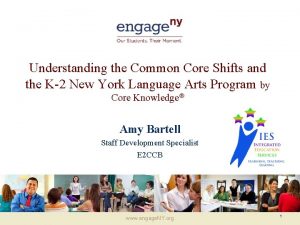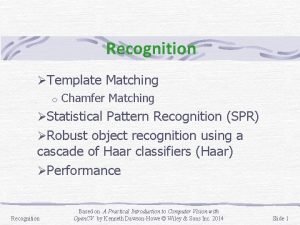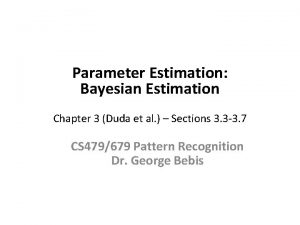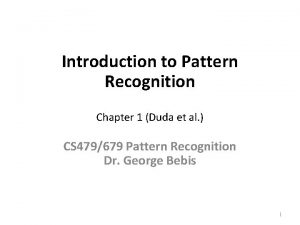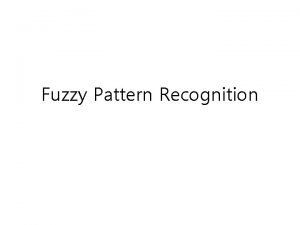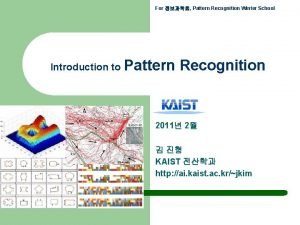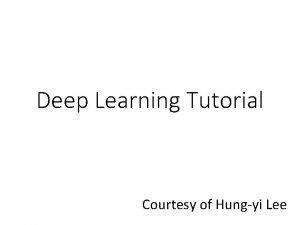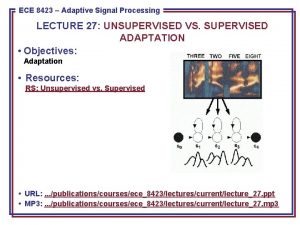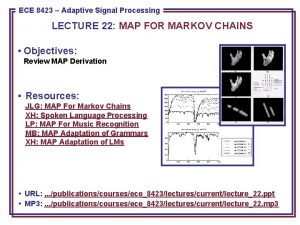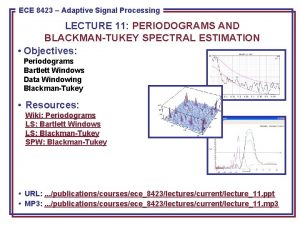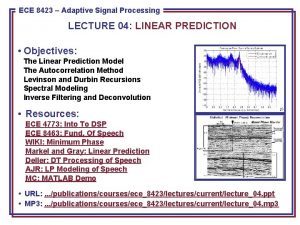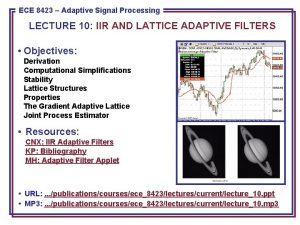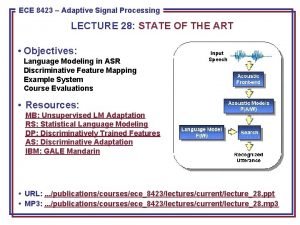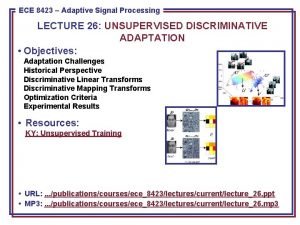ECE 8423 8443Adaptive Pattern Recognition ECE Signal Processing










- Slides: 10

ECE 8423 8443––Adaptive Pattern Recognition ECE Signal Processing LECTURE 14: OPTIMAL AND ADAPTIVE ARRAYS • Objectives: Signal and Noise Models SNIR Maximization Least-Squares Minimization MMSE Adaptation Griffiths Adaptive Beamformer Griffiths-Jim Adaptive Beamformer • Resources: ICU: Wireless Communications Arraycom: Adaptive Antennae Andrea: Microphone Arrays SVC: Steerable Loudspeaker Arrays • URL: . . . /publications/courses/ece_8423/lectures/current/lecture_14. ppt • MP 3: . . . /publications/courses/ece_8423/lectures/current/lecture_14. mp 3

Introduction • When an array is subjected to directional interferences, or when the measurement noise is correlated between sensors, non-uniform weighting of the sensor outputs can produce superior results to uniform weighting. • There are several ways we can optimize these weights: § Maximization of output Signal-to-Noise plus Interference Ratio (SNIR) § Minimization of Mean-Squared Error § Maximum Likelihood § Minimum Noise Variance • All four produce results that are typically very similar. • The output of the array can be written as (following the complex signal formulation): • The array output power is: ECE 8423: Lecture 14, Slide 1

Noise Characterization • The signal component of the output power is: • We can write the noise plus interference correlation matrix as: • The noise output power is: ECE 8423: Lecture 14, Slide 2

Maximizing the Signal-to-Noise Plus Interference Ratio • We can define the output Signal-to-Noise plus Interference Ratio (SNIR): • We can maximize the SNIR using the method of Lagrange multipliers: where k is a complex constant. To maximize J, we need the following identity: • We can differentiate J with respect to w: • This is in the form of an eigenvalue problem where the eigenvalues are the values of the SNIR and the eigenvectors are the array weights. There are N distinct eigenvalues of A, and the largest, max, maximizes the SNIR. • The corresponding eigenvector, wsn, represents the array weights. ECE 8423: Lecture 14, Slide 3

Solving for the Weights • We can derive an expression for the weights as follows: ECE 8423: Lecture 14, Slide 4

Example: Broadside Signal • Assume a broadside signal and sensors corrupted by uncorrelated noise: • This confirms our result for the delay and sum beamformer in the case of a broadside signal. ECE 8423: Lecture 14, Slide 5

Least-Squares Minimization • We can derive an alternate solution by minimizing the mean-square error. However, we need to use a pilot signal (the desired signal). • Define the error as usual: • We can differentiate with respect to w and show: • For our narrowband signal, we can show: • These solutions are different by a constant. ECE 8423: Lecture 14, Slide 6

Griffiths Adaptive Beamformer • The simplest adaptive beamforming approach is to use MMSE: • This has the usual solution: • Application of LMS to beamforming not as straightforward because the desired signal, d(n), contains no explicit spatial information. • The Griffiths Adaptive Beamformer operates directly on delayed versions of the sensor outputs: • The vector g, is just the steering vector, which requires knowledge of the direction of the desired signal, which can be estimated heuristically. ECE 8423: Lecture 14, Slide 7

The Griffiths-Jim Adaptive Beamformer ECE 8423: Lecture 14, Slide 8

Summary • Introduced a method for optimizing the weights of an array to maximize the SNIR. • Compared this to a least squares solution. • Introduced the Griffiths adaptive beamformer that requires knowledge of the direction of arrival of the signal. • Introduced a modification of this known as the Griffiths-Lim beamformer that is a generalization that decouples the problems of beamforming to enhance the signal and side-lobe cancellation to suppress the noise. ECE 8423: Lecture 14, Slide 9
 Pattern and pattern classes in image processing
Pattern and pattern classes in image processing Four part processing model for word recognition
Four part processing model for word recognition Four part processing model for word recognition
Four part processing model for word recognition Chamfer matching
Chamfer matching Bayesian estimation
Bayesian estimation Pattern recognition duda
Pattern recognition duda Fuzzy classification in pattern recognition
Fuzzy classification in pattern recognition Design cycle of pattern recognition
Design cycle of pattern recognition Pattern recognition
Pattern recognition Pattern recognition lab
Pattern recognition lab Pattern recognition clinical reasoning
Pattern recognition clinical reasoning

